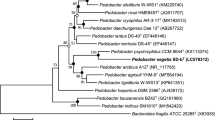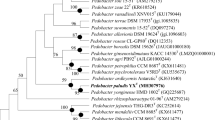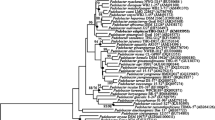Abstract
A Gram-negative, aerobic, non-motile, pink and rod-shaped bacterium, designated E01020T, was isolated from soil collected from the Chinese Great Wall Station, Antarctica. Comparative analysis of 16S rRNA gene sequences revealed that strain E01020T is a member of the genus Pedobacter, related to Pedobacter alluvionis DSM 19624T (96.8% similarity), Pedobacter agri JCM 15120T (96.5% similarity) and Pedobacter chinensis JDX94T (96.3% similarity). The dDDH values and ANI values of strain E01020T with closely related strains indicate that it can be distinguished from them as a novel species. The DNA G+C content was determined to be 35.2 mol%. The growth of strain E01020T was observed at 4–25 °C (optimal 20 °C), in the presence of 0–1% NaCl (w/v, optimal 0%) and at pH 6.0–8.0 (optimal pH 7.0). Strain E01020T was found to contained menaquinon-7 (MK-7) as only respiratory quinone, iso-C15:0, iso-C17:0 3-OH and Summed feature 3 (C16:1ω6c and/or C16:1ω7c) as major fatty acids. The major polar lipids were phosphatidylethanolamine, one unidentified lipid and two unidentified aminolipids. On the basis of the results of the phylogenetic and phenotypic analyses, it was suggested that strain E01020T represents a novel species of the genus Pedobacter, for which the name Pedobacter changchengzhani sp. nov. is proposed. The type strain is E01020T (= KCTC 62990T = MCCC 1H00357T).

Similar content being viewed by others
References
Baik KS, Park YD, Kim MS, Park SC, Moon EY, Rhee MS, Choi JH, Seong CN (2007) Pedobacter koreensis sp. nov., isolated from fresh water. Int J Syst Evol Microbiol 57:2079–2083
Besemer J, Lomsadze A, Borodovsky M (2001) GeneMarkS: a self-training method for prediction of gene starts in microbial genomes. Implications for finding sequence motifs in regulatory regions. Nucleic Acids Res 29:2607–2618
CLSI (2018) Performance standards for antimicrobial susceptibility testing, 28th edn. Clinical and Laboratory Standards Institute, Wayne
Da X, Jiang F, Chang X, Ren L, Qiu X, Kan W, Zhang Y, Deng S, Fang C, Peng F (2015) Pedobacter ardleyensis sp. nov., isolated from soil in Antarctica. Int J Syst Evol Microbiol 65:3841–3846
Dong XZ, Cai MY (2001) Determinative manual for routine bacteriology. Scientific Press, Beijing
Farfán M, Montes MJ, Marqués AM et al (2014) Reclassification of Sphingobacterium antarcticum Shivaji et al. 1992 as Pedobacter antarcticus comb. nov. and Pedobacter piscium (Takeuchi and Yokota 1993) Steyn et al. 1998 as a later heterotypic synonym of Pedobacter antarcticus. Int J Syst Evol Microbiol 64:863–868
Felsenstein J (1981) Evolutionary trees from DNA sequences: a maximum likelihood approach. J Mol Evol 17:368–376
Felsenstein J (1985) Confidence limits on phylogenies: an approach using the bootstrap. Evolution (NY) 39:783–791
Fitch WM (1971) Towards defining the course of evolution: minimum change for a specific tree toplogy. Syst Biol 20:406–416
Gallego V (2006) Pedobacter aquatilis sp. nov., isolated from drinking water, and emended description of the genus Pedobacter. Int J Syst Evol Microbiol 56:1853–1858
Gordon NS, Valenzuela A, Adams SM, Ramsey PW, Pollock JL, Holben WE, Gannon JE (2009) Pedobacter nyackensis sp. nov., Pedobacter alluvionis sp. nov. and Pedobacter borealis sp. nov., isolated from Montana flood-plain sediment and forest soil. Int J Syst Evol Microbiol 59:1720–1726
Klappenbach JA, Goris J, Vandamme P, Coenye T, Konstantinidis KT, Tiedje JM (2007) DNA-DNA hybridization values and their relationship to whole-genome sequence similarities. Int J Syst Evol Microbiol 57:81–91
Kroppenstedt RM (1982) Separation of bacterial menaquinones by HPLC using reverse phase (RP18) and a silver loaded ion exchanger as stationary phases. J Liq Chromatogr 5:2359–2367
Kumar S, Stecher G, Tamura K (2016) MEGA7: molecular evolutionary genetics analysis version 7.0 for bigger datasets. Mol Biol Evol 33:1870–1874
Liu QQ, Wang Y, Li J, Du ZJ, Chen GJ (2014) Saccharicrinis carchari sp. nov., isolated from a shark, and emended descriptions of the genus Saccharicrinis and Saccharicrinis fermentans. Int J Syst Evol Microbiol 64:2204–2209
Lowe TM, Eddy SR (1997) tRNAscan-SE: a program for improved detection of transfer RNA genes in genomic sequence. Nucleic Acids Res 25:955–964
Meier-Kolthoff JP, Auch AF, Klenk HP, Göker M (2013) Genome sequence-based species delimitation with confidence intervals and improved distance functions. BMC Bioinform 14:60
Minnikin DE, O’Donnell AG, Goodfellow M, Alderson G, Athalye M, Schaal A, Parlett JH (1984) An integrated procedure for the extraction of bacterial isoprenoid quinones and polar lipids. J Microbiol Methods 2:233–241
Mu DS, Liang QY, Wang XM, Lu DC, Shi MJ, Chen GJ, Du ZJ (2018) Metatranscriptomic and comparative genomic insights into resuscitation mechanisms during enrichment culturing. Microbiome 6:230
Qiu X, Qu Z, Jiang F, Ren L, Chang X, Kan W, Fang C, Peng F (2014) Pedobacter huanghensis sp. nov. and Pedobacter glacialis sp. nov., isolated from Arctic glacier foreland. Int J Syst Evol Microbiol 64:2431–2436
Roh SW, Quan Z-X, Nam Y-D, Chang H-W, Kim K-H, Kim M-K, Im W-T, Jin L, Kim S-H, Lee S-T, Bae J-W (2008) Pedobacter agri sp. nov., from soil. Int J Syst Evol Microbiol 58:1640–1643
Saitou N, Nei M (1987) The neighbor-joining method: a new method for reconstructing phylogenetic trees. Mol Biol Evolut 4:406–425
Sasser M (2001) Identification of bacteria by gas chromatography of cellular fatty acids. Midi Tech Note 101
Smibert RM, Krieg NR (1994) Phenotypic characterization. In: Gerbardt P, Murray RGE, Wood WA, Krieg NR (eds) Methods for general and molecular bacteriology. American Sociey for Microbiology, Washington, pp 607–654
Steyn PL, Segers P, Vancanneyt M, Sandra P, Kersters K, Joubert JJ (1998) Classification of heparinolytic bacteria into a new genus, Pedobacter, comprising four species: Pedobacter heparinus comb. nov., Pedobacter piscium comb. nov., Pedobacter africanus sp. nov. and Pedobacter saltans sp. nov. proposal of the family Sphingobacteriaceae fam. nov. Int J Syst Bacteriol 48:165–177
Švec P, Králová S, Busse HJ, Kleinhagauer T, Pantůček R, Mašlaňová I, Cnockaert M, Vandamme P, Staňková E, Gelbíčová T, Holochová P, Barták M, Kýrová K, Sedláček I (2017) Pedobacter jamesrossensis sp. nov., Pedobacter lithocola sp. nov., Pedobacter mendelii sp. nov. and Pedobacter petrophilus sp. nov., isolated from the Antarctic environment. Int J Syst Evol Microbiol 67:1499–1507
Tindall B, Sikorski J, Smibert R, Krieg N (2007) Phenotypic characterization and theprinciples of comparative systematics. Methods for general and molecular microbiology, 3rd edn. American Society for Microbiology, Washington, pp 330–393
Xia HF, Li XL, Liu QQ, Miao TT, Du ZJ, Chen GJ (2013) Salegentibacter echinorum sp. nov., isolated from the sea urchin Hemicentrotus pulcherrimus. Antonie Van Leeuwenhoek 104:315–320
Yoon SH, Ha SM, Lim J, Kwon S, Chun J (2017) A large-scale evaluation of algorithms to calculate average nucleotide identity. Antonie Van Leeuwenhoek 110:1281–1286
Zhang B, Liu ZQ, Zheng YG (2018) Pedobacter quisquiliarum sp. nov., isolated from activated sludge. Int J Syst Evol Microbiol 68:438–442
Zhou Z, Jiang F, Wang S, Peng F, Dai J, Li W, Fang C (2012) Pedobacter arcticus sp. nov., a facultative psychrophile isolated from Arctic soil, and emended descriptions of the genus Pedobacter, Pedobacter heparinus, Pedobacter daechungensis, Pedobacter terricola, Pedobacter glucosidilyticus and Pedobacter lentus. Int J Syst Evol Microbiol 62:1963–1969
Zhou LY, Chen XY, Du ZJ, Mu D (2019) Pedobacter chinensis sp. nov., a cellulose-decomposing bacterium from Arctic tundra soil. Int J Syst Evol Microbiol 69:1926–1933
Funding
This work was supported by the funding from National Key R&D Program of China (2018YFC1406903), Science and Technology Basic Resources Investigation Program of China (2017FY100300) and the SOA Key Laboratory for Polar Science, Polar Research Institute of China (KP201705).
Author information
Authors and Affiliations
Corresponding authors
Ethics declarations
Conflict of interest
The authors declare that there are no conflicts of interest.
Ethical approval
This article does not contain any studies with human participants or animal experiments by any of the authors.
Additional information
Publisher's Note
Springer Nature remains neutral with regard to jurisdictional claims in published maps and institutional affiliations.
Electronic supplementary material
Below is the link to the electronic supplementary material.
Rights and permissions
About this article
Cite this article
He, RH., Liu, ZW., Yu, Y. et al. Pedobacter changchengzhani sp. nov., isolated from soil of Antarctica. Antonie van Leeuwenhoek 112, 1747–1754 (2019). https://doi.org/10.1007/s10482-019-01305-4
Received:
Accepted:
Published:
Issue Date:
DOI: https://doi.org/10.1007/s10482-019-01305-4




